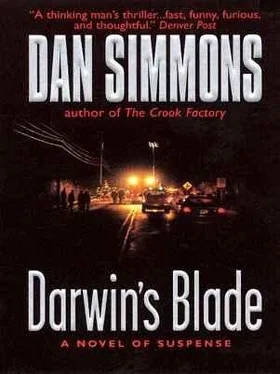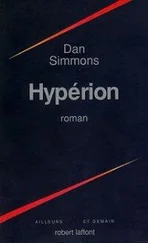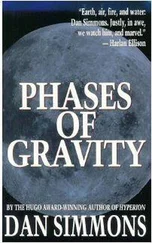Dan Simmons - Darwin's Blade
Здесь есть возможность читать онлайн «Dan Simmons - Darwin's Blade» весь текст электронной книги совершенно бесплатно (целиком полную версию без сокращений). В некоторых случаях можно слушать аудио, скачать через торрент в формате fb2 и присутствует краткое содержание. Год выпуска: 2000, Жанр: Триллер, на английском языке. Описание произведения, (предисловие) а так же отзывы посетителей доступны на портале библиотеки ЛибКат.
- Название:Darwin's Blade
- Автор:
- Жанр:
- Год:2000
- ISBN:нет данных
- Рейтинг книги:3 / 5. Голосов: 1
-
Избранное:Добавить в избранное
- Отзывы:
-
Ваша оценка:
- 60
- 1
- 2
- 3
- 4
- 5
Darwin's Blade: краткое содержание, описание и аннотация
Предлагаем к чтению аннотацию, описание, краткое содержание или предисловие (зависит от того, что написал сам автор книги «Darwin's Blade»). Если вы не нашли необходимую информацию о книге — напишите в комментариях, мы постараемся отыскать её.
Darwin's Blade — читать онлайн бесплатно полную книгу (весь текст) целиком
Ниже представлен текст книги, разбитый по страницам. Система сохранения места последней прочитанной страницы, позволяет с удобством читать онлайн бесплатно книгу «Darwin's Blade», без необходимости каждый раз заново искать на чём Вы остановились. Поставьте закладку, и сможете в любой момент перейти на страницу, на которой закончили чтение.
Интервал:
Закладка:
The FBI shooters were armed with the most modern equipment available—modified De Lisle Mark 5 sniper rifles firing 7.62 mm rounds in either standard or subsonic combinations. The rifles were descended from Dar’s venerable Remington 700 bolt-action model, but had evolved about as far as space shuttle pilots had from the first African australopithecine hominids. The weapons utilized heavy match barrels with integral suppressors—“silencers” to the layman—which, when combined with subsonic ammunition, allowed for accuracy at ranges of more than two hundred yards. The rifles made no sound, not even the smack of a bullet breaking the sound barrier.
Mounted on each De Lisle Mark 5 was a single, lightweight, integrated sight which combined a powerful telescopic sight with an image-intensifying night sight, an infrared range finder, and a thermal imager. The FBI snipers could kill at two hundred yards in the rain on a starless night through light fog or smoke.
The rest of the FBI assault teams were outfitted with Kevlar helmets, full body armor, gas masks, infrared goggles, fully suppressed submachine guns with laser sights, .45-caliber fully automatic pistols, and stun grenades known in the trade as “flash bangs.” For the 5:00 A.M. assault on Thursday, the lead team would go in behind a barrage of tear gas projectiles fired through all the windows and use a man-carried hydraulic battering ram to take down the front door. Then the first three tac teams would enter the building by all available first-floor windows and doors. Waiting in the garage of the nearest house was a fully armored tactical assault vehicle with its own battering ram. Five helicopters were tasked to the assault, and each of them carried master marksmen. Two of the helicopters were equipped to drop men on lines for rapid assault from the air.
“Hardly seems like a fair fight,” Syd Olson suggested to Special Agent in Charge Warren on Wednesday afternoon.
Warren had given her the slightest of smiles. “If it becomes anything near a fair fight,” he said, “I deserve to be fired.”
Syd had nodded and called Dar at his condo to see how he was doing.
Dar was doing fine by Wednesday afternoon. He had used the morning to catch up on work in his warehouse apartment—documenting the fatal Gomez swoop-and-squat and preparing a computer-animated reenactment of Attorney Esposito’s death by scissors lift. He chatted with Syd a few minutes, telling her that he was going up to his cabin to get a good night’s sleep while she and her colleagues did all the hard work the next day. He asked her to be careful, promised to see her on Thursday, and wished her luck.
Dar had spent all of the previous afternoon and evening zeroing his two weapons. Using the ravine to the east of the cabin—it was sixty feet wide where the gold mine opened into it, narrowing to less than twenty feet in width up the hill parallel to where Dar had found the potential sniper roosts—he fired off several hundred rounds of ammunition from both his old M40 bolt-action and the loaner Light Fifty.
Dar used a new purchase—a $3,295 pair of new Leica Geovid BDII range-finding binoculars—to double-check the range with the Leica’s built-in laser range finder as he set out targets at distances of 100 yards, 300 yards, 650 yards, and 1,000 yards. Dar was capable of thinking in meters, but like most old-time snipers, he did range-finding calculations in yards. He was pleased that his visual estimates of target distance in each case fell within five feet of the laser’s readout. The Leica’s range finder itself was guaranteed to be accurate to within three feet at 1,100 yards.
Although Dar had fired the M40—the old modified Remington 700 hunting rifle—occasionally on shooting ranges in the past few years, he still had to reacquaint himself with the weapon. When he had been trained as a young Marine, it was discovered that Dar had 20/10 vision, which meant simply that what was perfectly clear for a person with 20/20 vision at one hundred yards was just as clear to Dar at two hundred yards. Even before Dar had decided for certain on becoming an outcast through advanced sniper training, he had qualified as an “expert rifleman” at Parris Island boot camp. In the time-honored tradition of the Corps, riflemen could qualify in three categories—marksman, sharpshooter, and—very, very rarely—expert rifleman. Dar had qualified as expert rifleman on Record Day with 317 points out of a possible 330, a distinction that was rare enough that his commanding officer had told him that only a dozen Marines had equaled it going back to World War II. The first 317 score had been made by a Marine who went on to be a famous writer and biographer.
The qualities that went into superb marksmanship included the control of breathing that was so important, extraordinary eyesight, patience, the ability to fire a weapon from several positions, and the ability to factor in distance, gravity, wind, and the weapon’s unique quirks with every shot. Another important—and underrated—requirement was cleverness with adjusting the rifle’s sling, a skill difficult to teach but which had come naturally to young Dar. Now, almost thirty years later, Dar knew that his eyesight had deteriorated to a mere 20/20 for distance shooting, but the comfort with the weapon, the ability to adjust the sling properly without thinking about it, the sense of proper range and ability to zero the weapon, the ability to fire easily and accurately from a prone, kneeling, sitting, and standing position—all these remained.
Dar took great care that Tuesday afternoon to zero the M40. His modified Redfield scope was fitted with mil-dot reticles as well as elevation and windage turrets. He adjusted the elevation turret according to the different ranges he was firing, and clicked the windage turret left to right to compensate for the lateral effects of wind on the bullet. The “zero” of the weapon was simply the setting required to put a shot exactly on target center at any given range with no wind blowing. Here the ravine came in handy because it blocked the prevailing winds from the west and allowed Dar to zero the weapon at all distances during lulls when there was no breeze whatsoever.
During advanced sniper training at Quantico and again in Vietnam, Dar had set his own accuracy requirements. Firing match-grade ammunition such as he was using now, Dar was not satisfied unless he could group his shots within a diameter of 20 millimeters at a range of one hundred yards, 125 millimeters at six hundred yards, and 300 millimeters—regularly—at one thousand yards. The final goal was not as generous as it sounded, Dar knew, because it took a bullet fired from his M40 approximately one second to travel six hundred yards, but a full two seconds to travel one thousand yards. Two seconds is an eternity in ballistics. Wind variations come into play over such a huge amount of time, and if the target is moving…forget it.
Dar spent five hours on Tuesday firing the M40 from all four positions—prone, sitting, kneeling, and standing. He would assume the position, feeling the sling snug tight and right, the stock tight against his cheek, a “spot weld” of contact between his cheek and his thumb on the small of the wooden stock, trigger finger positioned on the trigger with no contact with the side of the stock, his breathing so calm as to be imperceptible. And then he would close his eyes for several seconds. If, when he opened his eyes, the crosshairs in the scope were still precisely on his previous aiming point, he knew that he had obtained a so-called natural point of aim.
The hardest thing for Dar to recapture was trigger control. This had come natural to him in the Marines, but he knew from firing-range practice that he had to work to find it now. Trigger control was nothing more complicated than taking up the slack at precisely the correct point in his breathing cycle while he fine-tuned his aim, then squeezing the trigger the extra millimeter needed without moving the rifle in any way. It was not complicated, but it took mental focus, muscle control, and breathing control.
Читать дальшеИнтервал:
Закладка:
Похожие книги на «Darwin's Blade»
Представляем Вашему вниманию похожие книги на «Darwin's Blade» списком для выбора. Мы отобрали схожую по названию и смыслу литературу в надежде предоставить читателям больше вариантов отыскать новые, интересные, ещё непрочитанные произведения.
Обсуждение, отзывы о книге «Darwin's Blade» и просто собственные мнения читателей. Оставьте ваши комментарии, напишите, что Вы думаете о произведении, его смысле или главных героях. Укажите что конкретно понравилось, а что нет, и почему Вы так считаете.












